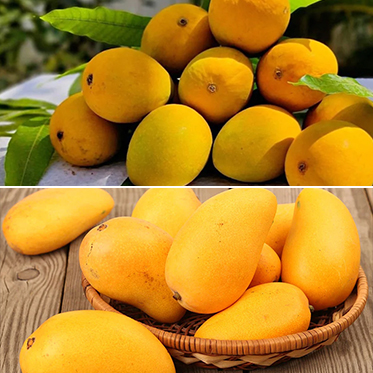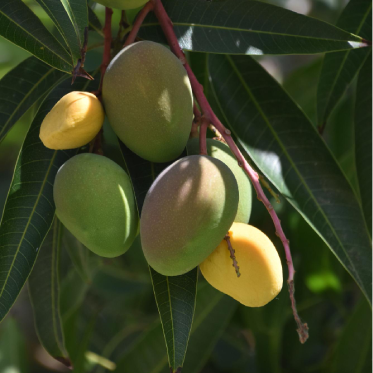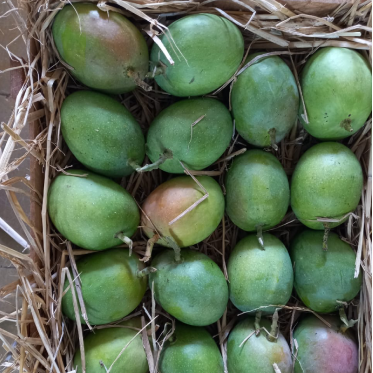1. Origin and Geographic Indication (GI)
Ratnagiri Alphonso Mango:
- Origin: Grown in the coastal Ratnagiri district of Maharashtra.
- GI Tag: Recognized under the GI system, covering Ratnagiri and neighboring areas.
- Climatic Influence: Grown in a humid, coastal environment, giving it a distinct taste and aroma.
Gir Kesar Mango:
- Origin: Grown in the Gir region of Gujarat, especially around Junagadh and Talala.
- GI Tag: Also recognized under the GI system as “Gir Kesar Mango.”
- Climatic Influence: Cultivated in a semi-arid region, benefiting from dry conditions and the unique soil of Gujarat.
2. Appearance
Ratnagiri Alphonso Mango:
- Shape: Oval with a tapered end.
- Color: Golden-yellow with a reddish tinge on the top when fully ripe.
- Skin: Thin and smooth.
Gir Kesar Mango:
- Shape: Slightly rounder and broader compared to Alphonso.
- Color: Deep orange to saffron (hence the name “Kesar,” meaning saffron in Hindi).
- Skin: Slightly thicker and may have a reddish-green tinge when ripe.
3. Flavor and Aroma
Ratnagiri Alphonso Mango:
- Flavor: Exceptionally rich, creamy, and sweet with a hint of tanginess.
- Aroma: Intense, fruity fragrance with a floral note, considered the “King of Mangoes” for its unparalleled taste.
Gir Kesar Mango:
- Flavor: Distinctly sweet and slightly less tangy compared to Alphonso. It has a smooth, fiber-free pulp.
- Aroma: Mildly aromatic with a unique saffron-like fragrance.
4. Pulp and Texture
Ratnagiri Alphonso Mango:
- Pulp: Deep orange, fiberless, and buttery.
- Texture: Smooth and melts in the mouth.
Gir Kesar Mango:
- Pulp: Vibrant orange, slightly denser than Alphonso.
- Texture: Juicy and smooth, though slightly thicker.
5. Harvesting Season
Ratnagiri Alphonso Mango:
- Harvest: March to May.
- Early season mangoes are smaller; peak season fruits are larger and sweeter.
Gir Kesar Mango:
- Harvest: May to July.
- Often available slightly later than Alphonso, extending the mango season.
6. Price
Ratnagiri Alphonso Mango:
- Premium-priced due to limited production, high demand, and export value.
- Considered more luxurious because of its intense flavor and delicate nature.
Gir Kesar Mango:
- Relatively more affordable, with wider availability.
- Valued for its sweetness and saffron-like fragrance, but generally less expensive than Alphonso.
7. Cultivation and Soil
Ratnagiri Alphonso Mango:
- Soil: Grows in lateritic soils rich in iron and nutrients, with good drainage.
- Climate: Humid coastal climate enhances its unique flavor.
Gir Kesar Mango:
- Soil: Thrives in the alluvial and black soils of Gujarat.
- Climate: Dry, arid conditions with ample sunlight enhance its sweetness and shelf life.
8. Export and Demand
Ratnagiri Alphonso Mango:
- Highly demanded in international markets like Europe, the Middle East, and the USA.
- Known for its exclusivity and association with luxury.
Gir Kesar Mango:
- Popular in domestic markets and some international markets.
- Its affordability and extended shelf life make it widely accessible.
Summary Table
| Feature | Ratnagiri Alphonso Mango | Gir Kesar Mango |
| Region | Ratnagiri (Maharashtra) | Gir (Gujarat) |
| Color | Golden-yellow with reddish hue | Saffron-orange |
| Flavor | Rich, sweet-tangy, creamy | Sweet, less tangy |
| Aroma | Intense, floral-fruity | Mild, saffron-like |
| Season | March-May | May-July |
| Pulp Texture | Fiberless, buttery | Smooth, juicy |
| Price | Expensive | Affordable |
Both mangoes are prized for their unique qualities and play a significant role in India’s mango diversity, catering to different preferences and markets.












